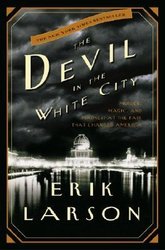The Devil in the White City by Erik Larson
Review of The Devil in the White City by Erik Larson
The Devil in the White City by Erik Larson (2003). Published by Crown Publishers.
There was a point in time where this book was constantly appearing in my life. It was on social media, being recommended to me by friends, pushed on advertisements.
I had no interest in reading for this for a hot minute, but it wasn’t until graduate school that I finally decided to hold up my white flag and read this book.
I asked for a copy for Christmas, my mother got it for me, and then I read all of the book while on a flight to the West Coast, as I was on a nonstop flight to San Diego at the time.
And man, what a book this is. It kind of has an interconnected split storyline at times, but I can see why people like this book so much.
I remember there was a time as well when Leo DiCaprio was said to have bought the rights to turn this into a television show, and, to be honest, I would watch that series if it ever sees the light of day. I’ll be patiently waiting and reviewing other things in the mean time.
Let’s get into the review before I start rambling too much! Apologies for the weirdly tiny graphic of the book cover as well; for some reason, I can’t find a decent picture of the cover.
The story of a serial killer and the 1993 Chicago World’s Fair.
So The Devil in the White City is quite the unique book, as it splits itself into multiple stories that are related solely through the fact that the city of Chicago is rapidly developing in order to show how the World’s Fair is happening that year.
I think this split method might work for some people, but others might honestly find it kind of frustrating for how it jumps back and forth, as the book feels like it’s two different ones at times. If you’re interested in one aspect and not the other, this is definitely going to be a painful read.
In one storyline, we meet H.H. Holmes, who had moved to Chicago after graduating from medical school. He begins operating under the alias H.H. Holmes, which isn’t his real name, and he starts working at a drugstore. Eventually, he buys it from the owner, then builds a hotel on an empty lot right near by.
What he does with this hotel is lure people in, especially young women, and then kills them. He claims he killed almost thirty people, but only a couple are actually confirmed.
Larson goes into detail the process in which Holmes set up shop and then planned to kill his victims, and if you’re queasy about the details, this might not be the book for you.
On the other hand, the other side of this book is about the Chicago architect Daniel Burnham. When Chicago was announced as the place for the World’s Fair that year, the government realized they needed to beautify the city before all of these people started showing up.
Enter Burnham, his partner, and their firm trying to get together the perfect white city before the fair starts. It certainly had its ups and its downs, which Larson meticulously tracks of the course of this book, but they end up getting things together in time.
At one point, his business partner, Root, even dies tragically young, leaving Burnham alone with the company while trying to get things together in time.
That said, we do get a bit of the World Fair towards the end of the book. I found this part to be fascinating in itself, as it describes several new inventions, such as the ferris wheel, that showed up at this world’s fair.
Technological innovation is incredible to me to learn about as an amateur historian, and the Chicago World’s Fair certainly was a period in which a lot of great things were unveiled.
Overall Thoughts
Overall, I’m glad I read this book, as I thought it was an interesting way to tell these kinds of stories. I have a physical copy in my collection, and I will probably be returning to it in the near future.
I found the split structure to work for my purposes, but, as I mentioned before, I can see how someone would really struggle with these kinds of books if they aren’t already invested in the content.
Despite that, I found quite a bit to admire in Larson’s writing style—besides the structural things I thought this was an accessible way to consume such dense history.
Follow me below on Instagram and Goodreads for more.


![Jeju-do (제주도) is one of those places that reminds you of how stunning the world is
[7.12.2024 부터 7.14.2024 까지]](https://images.squarespace-cdn.com/content/v1/5ea1f794501b7153b29e7cd7/1721033601522-554E76HR01JUHDWZBJ1I/image-asset.jpeg)









